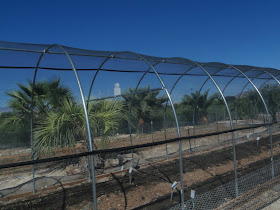 Two magnolia planted on the east side of Las Vegas showing some signs of stress with dieback on the tops and sides. Old magnolias for Las Vegas
Two magnolia planted on the east side of Las Vegas showing some signs of stress with dieback on the tops and sides. Old magnolias for Las VegasA. I have said this before but it probably doesn’t hurt to say it again. When we plant trees, shrubs or any other plant for that matter that is out-of-place in our desert environment then it will cost us more time, energy and money to take good care of it. Magnolia is clearly out of its element here in the desert. So it will require more from you to make it healthy and keep it in good shape.
The acidifier might be of some help but you can get excellent acidification from compost and decaying organic matter such as wood mulches.
I hope they are not planted in rock mulch. That will be their doom if they are. Try adding compost around the tree and watering it in if you can. The fertilizer you’re using is fine but I would also recommend an iron chelate as a fertilizer applied now which contains EDDHA in the ingredients.
 |
| Magnolias planted near a west facing wall on a building in rock (boulder) mulch in Las Vegas. OMG. |













